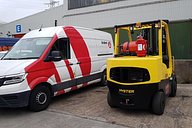Fire Suppression Focus: Waste And Recycling Shredders
Recycling and waste shredders operate in some of the most demanding industrial conditions. Designed to achieve the lowest cost per tonne, they typically operate for extended hours with minimal human involvement. Given that they also handle highly combustible materials, they’re a very high fire risk - with hazards that need to be managed correctly to avoid consequences going beyond simply damaging a machine.
Whether it’s a mobile or stationary shredder, an automatic recycling and waste management fire suppression system is a must to protect the machine, site, and staff against the high risk of fire. However, not all systems available in the market are designed to provide effective and reliable fire protection to these assets. Here, we highlight considerations to make when choosing recycling and waste management fire suppression.
How do waste shredder fires start?
For a fire to occur, three things are necessary: heat, a fuel source, and oxygen. The environments in which shredders operate are abundant in highly combustible fuel sources – wood chippings, biomass, paper, and cardboard, to name a few. These materials can quickly build up in the engine compartment and belly pan of the machine. When combined with heat generated by engine components, turbochargers, and exhaust manifolds, materials can quickly ignite. And with plenty of fuel to feed it, the fire can rapidly spread.
Waste shredders routinely operate unmanned for prolonged periods of time, which can worsen the situation and allow a fire to develop significantly before it’s discovered.
In addition, shredders often work inside sheds or other facilities, meaning fires can spread to stock or products, increasing business losses and going far beyond machine damage.
What are the main fire hazard areas?
The following areas pose a fire hazard in waste shredders as they are either a source of fuel or heat. However, fire hazards will differ from model to model, working environment, and work schedule, so we always recommend a fire hazard analysis on each machine.

Common fuel sources in waste shredders include a build-up of debris (accumulating in areas such as the engine compartment and belly pan), as well as flammable fluids, fuels, oils, and greases. On the other hand, the engine, exhaust manifold, and turbocharger often reach very high temperatures which, when in contact with any fuel source, can cause a fire to start.
What extinguishing agents are required?
Due to the high amounts of combustible material in shredders, the risk of fire re-ignition after the system has discharged is significantly high.
Re-ignition can happen when flammable materials come into contact with extremely hot surfaces (such as turbochargers or exhaust manifolds) after the recycling and waste management fire suppression system has discharged.
The best way to achieve rapid fire suppression and significantly reduce the risk of fire re-ignition is to install a Twin Agent fire suppression system. These systems combine dry and wet chemical extinguishing agents:
- Dry chemical agent: Provides rapid fire knock-down and excellent coverage of the hazard areas, however its cooling capabilities are limited.
- Wet chemical agent: Cools down super-heated components such as the turbocharger and exhaust manifold to help protect against fire re-ignition.
The quantity of each extinguishing agent must be adequate to cover all identified fire hazard areas through strategically located discharge nozzles.
What other system features are recommended?
As shredders often operate unattended and in remote locations, automatic engine shutdown and battery isolation are also important to help minimise the potential of fire re-flash.
When a fuel or hydraulic line or connection fails, it can spray fluid on to a super-heated component and start a fire. As long as the engine continues to operate, this fluid will continue to fuel the fire. Additionally, damaged wiring can be a source of electrical fire. By including an option to cut power to the battery and fuel to the engine, we can significantly reduce the risk of fire re-ignition.
A sounder beacon can also be helpful to alert the staff in the event of a recycling and waste management fire suppression system detecting a fire.
Tailored recycling and waste management fire suppression solutions
When it comes to fire suppression, waste shredders pose specific challenges that need to be considered in order to provide the right level of fire protection.
Some fire suppression suppliers offer single agent systems to protect shredders, but this is not always sufficient to protect these machines in the event of a fire. We strongly recommend fitting a twin agent recycling and waste management fire suppression system. The quantity of extinguishing agents and number of discharge nozzles are also important aspects of effective fire suppression.
For more information on how to protect shredders and other machines against the risk of fire, request a callback from our industry specialists.
Related News

Fire Suppression Focus: Forklifts
Key considerations when choosing fire suppression for forklifts.

Q&A with Lily Asbury
Introducing Lily, our kind-hearted Service & Support Co-Ordinator

Fire Suppression Basics: Fire Hazard Analysis
In this post, we look at the principles behind a fire hazard analysis and how they dictate system design parameters such as quantity of suppression agent.
